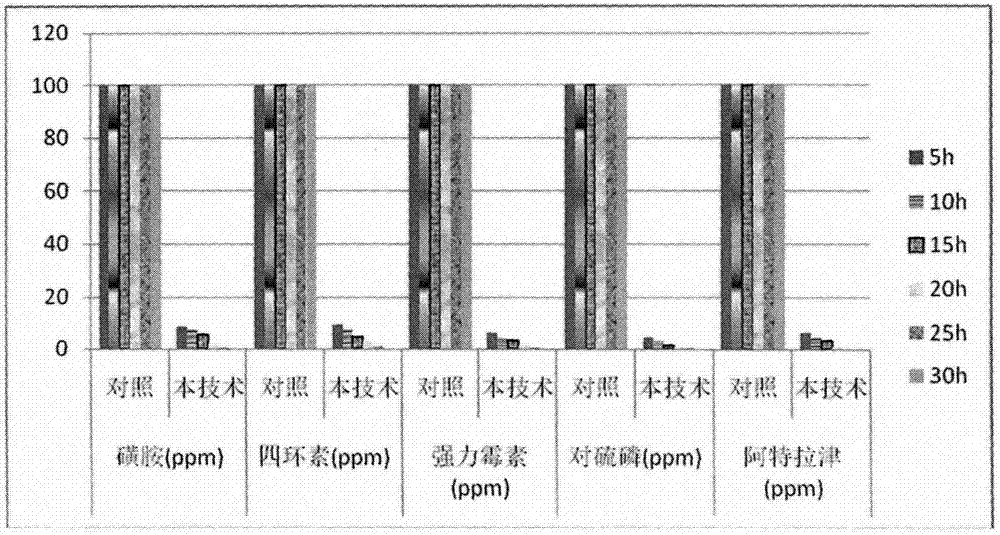Technology for removing residual antibiotics/ pesticides in oil in situ and remediating soil and application
A technology for antibiotics and soil, applied in the field of in-situ elimination and restoration of soil residual antibiotics and pesticides, can solve problems such as high cost, secondary pollution, and incomplete clearing, and achieve the effect of simple method, reduced investment, and simple and easy technology
- Summary
- Abstract
- Description
- Claims
- Application Information
AI Technical Summary
Problems solved by technology
Method used
Image
Examples
Embodiment 1
[0022] 1. In any soil contaminated with antibiotics and / or organic pesticides, add 1mol / LFeSO to 1000 kg of antibiotics and / or organic pesticides contaminated soil by mass / volume ratio 4 8 liters of solution, irradiated with a 1 kW UV lamp, sealed with plastic film, tents, or other coverings, and stirred the soil at the same time, paused after 1 hour, stirred the soil, and then added 1mol / L FeSO 4 8 liters of solution, continue to irradiate the soil with a 1 kW UV lamp for 1 hour, and this process can be repeated 4 times according to the degree of soil pollution and specific conditions;
[0023] 2. Add 10 liters of 30% hydrogen peroxide to the soil treated in the above 1, stir the soil immediately, seal and react for 0.5 hours, then add 10 liters of hydrogen peroxide, quickly stir the soil, and repeat this process 4 times according to the specific situation ;
[0024] 3. Add 10 liters of fresh ozone water (new ozone water produced by the ozone water machine) to the soil treat...
Embodiment 2
[0027] 1. In any soil contaminated with antibiotics and / or organic pesticides, add 3mol / LFeSO to 1000 kg of antibiotics and / or organic pesticides contaminated soil by mass / volume ratio 4 5 liters of solution, irradiated with a 3 kW UV lamp, sealed with plastic film, tents or other coverings, and stirred the soil at the same time, paused after 2 hours, stirred the soil, and then added 3mol / LFeSO 4 5 liters of solution, continue to irradiate the soil with a 3 kW UV lamp for 2 hours, and this process can be repeated 5 times according to the degree of soil pollution and specific conditions;
[0028] 2. Add 5 liters of 30% hydrogen peroxide to the soil treated in the above 1, stir the soil immediately, seal and react for 1 hour, then add 5 liters of hydrogen peroxide, quickly stir the soil, and repeat this process 6 times according to the specific situation ;
[0029] 3. Add 5 liters of fresh ozone water (newly produced ozone water by the ozone water machine) to the soil treated i...
Embodiment 3
[0032] 1. In any soil contaminated with antibiotics and / or organic pesticides, add 1mol / LFeSO to 1000 kg of antibiotics and / or organic pesticides contaminated soil by mass / volume ratio 4 The solution is 1 liter, irradiated with an 8 kW UV lamp, sealed with plastic film tents or other coverings, and stirred the soil at the same time, paused after 2 hours, stirred the soil, and then added 1mol / LFeSO 4 With 5 liters of solution, continue to irradiate the soil with an 8 kW UV lamp for 1-3 hours. According to the degree of soil pollution and specific conditions, this process can be repeated 3 times;
[0033] 2. Add 8 liters of 30% hydrogen peroxide to the soil treated in the above 1, stir the soil immediately, seal and react for 1 hour, then add 8 liters of hydrogen peroxide, quickly stir the soil, and repeat this process 3 times according to the specific situation ;
[0034] 3. Add 8 liters of fresh ozone water (new ozone water produced by the ozone water machine) to the soil tre...
PUM
 Login to View More
Login to View More Abstract
Description
Claims
Application Information
 Login to View More
Login to View More - R&D
- Intellectual Property
- Life Sciences
- Materials
- Tech Scout
- Unparalleled Data Quality
- Higher Quality Content
- 60% Fewer Hallucinations
Browse by: Latest US Patents, China's latest patents, Technical Efficacy Thesaurus, Application Domain, Technology Topic, Popular Technical Reports.
© 2025 PatSnap. All rights reserved.Legal|Privacy policy|Modern Slavery Act Transparency Statement|Sitemap|About US| Contact US: help@patsnap.com

